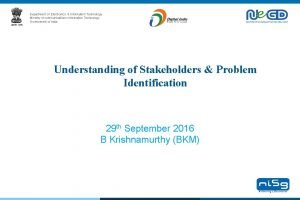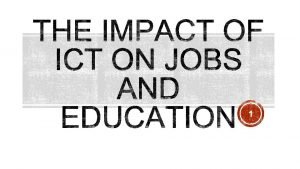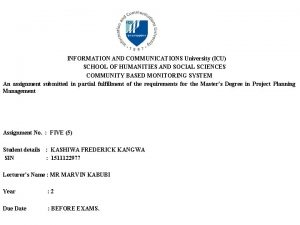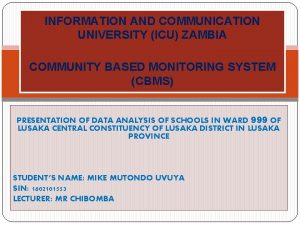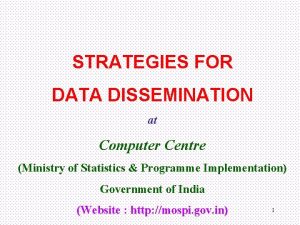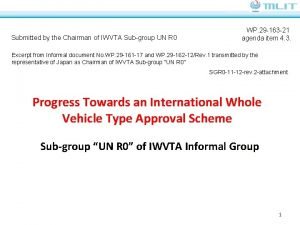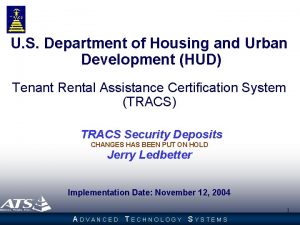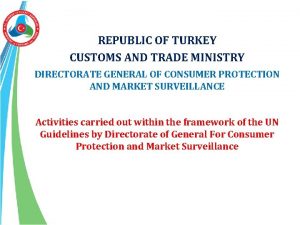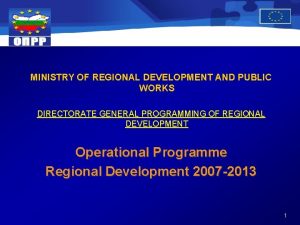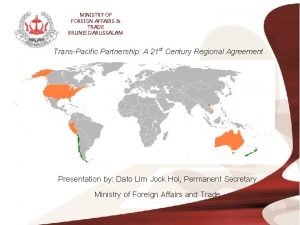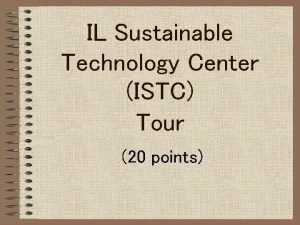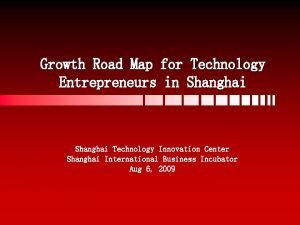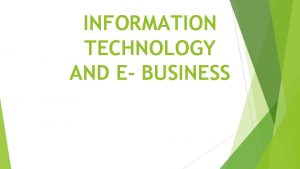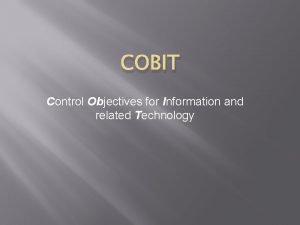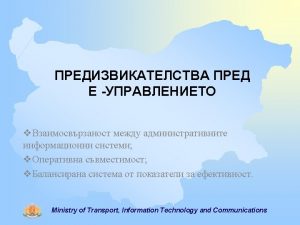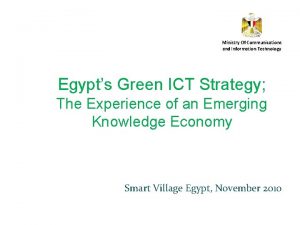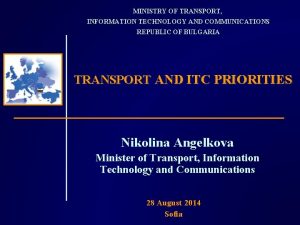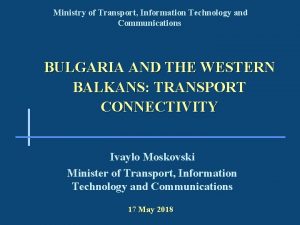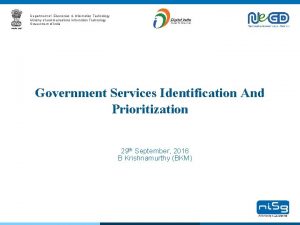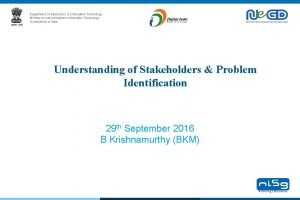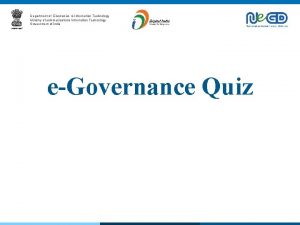Ministry of Communications and Information Technology Information Center






























































- Slides: 62

Ministry of Communications and Information Technology Information Center ICT measurement: Egypt’s Experience First Workshop of the Regional Project "ICT Indicators and Capacity Building for ICT Measurement in Arab Region", Amman, 25 -27 Sept. 2010 Dr. Nagwa El-Shenawy Information Center Director Ministry of communications and Information Technology

Content q ICT Indicators and Capacity Building for ICT Measurement in Arab Region project. . Importance and expected outcomes. q ICT measurement in Egypt: q Vision. q Goals. q Life cycle. q Scope of work: q ICT readiness. q ICT affordability. q ICT usage. q ICT impact. q Road Map. q Work Plan. q Main Deliverables.

ICT Indicators and Capacity Building for ICT Measurement in Arab Region project. . Importance and expected outcomes § Since the World Summit on the Information society (WSIS) (Geneva 2003 – Tunis 2005) “Measuring the Information Society” many international organizations have worked on developing ICT indicators and setting statistical standards to measure ICT infrastructure, usage and impact in countries. § It is important here to refer to the notable efforts of ITU, UNCTAD, WB, ESCWA, OECD, Eurostat to set international standards and methodologies to measure ICT indicators.

ICT Indicators and Capacity Building for ICT Measurement in Arab Region project. . Importance and expected outcomes Cont. § In spite of that, Arab ICT indicators still not sufficient not available and not publicized. § Hence, the ITU Arab regional office project for ICT Indicators and Capacity Building for ICT Measurement in Arab Region considers one of the main efforts needed in this area. § It is expected that this project will enhance ICT measurement in the Arab states and facilitate building a unified and comprehensive data base for Arab ICT indicators which will act as the most important reference point as well as policy makers for international organizations and all over the world.

ICT Measurement in Egypt • • • Vision. Goals. Life cycle. Scope of work. Selected samples.

ICT Measurement in Egypt. . Vision Developing and improving the measurement of ICT use and impact in Egypt, following international standards; so as to show the progress witnessed in ICT sector.

ICT Measurement in Egypt. . Goals § Building a database for ICT indicators within MCIT to measure, analyze and monitor ICT sector in Egypt according to international standards; taking into consideration lagging regions behind in order to bridge the digital divide. § Providing decision makers with up-to-date and accurate ICT indicators to help them setting and following up policies and strategies pertaining to ICT sector. § Providing international organizations with required data and indicators which reflect the positioning and the performance of ICT sector in Egypt. § Disseminating the ICT indicators to the public and policy makers.

ICT Measurement in Egypt. . Life cycle ICT Diffusion and statistical demand Measuring ICT Impact Measuring ICT Intensity Measuring ICT Readiness Source: Vincenzo Spiezia (2009), “Implementing the Seoul Agenda. Discussion points for the round table on “ICT measurement: Assessment and Proposals by Member Countries”, OECD Time

ICT Measurement in Egypt. . Scope of work ICT Readiness Infrastructure Indicators: -Fixed lines. -Mobile: -Subscription. -Data services ICT Affordability ICT Usage ICT Impact Tariff Indicators: Usage Indicators: Economic Indicators: -Fixed lines. -ICT value added. -Mobile. - Households and individuals. -Internet. - Private enterprises. -ICT contribution to GDP growth rate. - Government. -ICT contribution to GDP. - Education. -ICT Contribution to the treasury. -Narrowband. - Public Access points. -ICT exports. -Broadband: - Health (Forthcoming). -ICT demand supply multipliers. -Internet: -Fixed. -Mobile. - Other indicators. - ISPs. -others. Development: -PIACs. -others.

ICT Measurement in Egypt • ICT readiness: Ø Internet Users Calculation Method.

ICT Readiness. . Internet Users calculation method Internet users by access mode (Q 2 2010) Internet users (Million) 19. 84

ICT Readiness. . Internet Users calculation method Dial Up ISDN (ISDN Subscribers) … Source: TE (Average no. of persons using internet in each household) … Source: HH survey X (Unique Numbers) … Source: TE X (Average no. of persons using ISDN) … Source: Recommended by ITU ADSL Commercial Subscribers. . Source: calculated from ISPs survey Using ADSL subscribers figure X (Average no. of employees using Each ADSL line) … Source: Private sector survey + + ADSL HH Subscribers. . Source: calculated from ISPs survey using ADSL subscribers figure Mobile & USB Modem + (Mobile Internet users). . Source: NTRA X + (Average no. of HH using each ADSL line) … Source: HH survey (USB Internet users). . Source: NTRA + Estimated number of internet users Cont.

ICT Readiness. . Internet Users calculation method Cont. Estimated Internet users = (Unique numbers * 2. 5) + (Commercial ADSL Subscription * 16) + (Household ADSL subscription * 4 )+ (Leased line * 40) + (ISDN * 4 ) + (Mobile internet users) + (USB internet users). Note: Values of the abovementioned multipliers differ from country to another and it should reflect the results of the relevant ICT usage surveys and international norms.

ICT Measurement in Egypt • ICT Affordability: ØICT Price Basket.

ICT Affordability. . Price Basket § Price baskets are a set of affordability indicators developed by the World Bank to compare affordability of communication services between countries world wide on an annual basis. § These indicators are: price baskets for fixed lines, for mobiles and for internet services, and are all measured in USD. § MCIT has started calculating the same indicators for Egypt using local data on a quarterly basis since (Jan – March 2006) till the present. Calculations are done in EGP and then transferred into USD using the quarterly average of the monthly exchange rate of the EGP versus the USD release by the Central Bank of Egypt.

ICT Affordability. . Price Basket Cont. Price basket for fixed line § Calculated as one-fifth of the installation charge, the monthly subscription charge, and the cost of local calls (15 peak and 15 off-peak calls -which are the same cost in Egypt -of three minutes each). § The main changes occurring in this indicator usually result from offers and promotions in installation charges, aiming at increasing the number of subscribers in fixed telephones, in addition to the changes in the exchange rate or the minute rate.

ICT Affordability. . Price Basket Cont. Price basket for mobile § Calculated as the pre-paid price for 25 calls per month spread over the same mobile network, other mobile networks, and mobile to fixed calls and during peak, off-peak, and weekend times. It also includes 30 text messages per month. The prepaid tariffs of the operators resulting in the cheapest basket are used. § Each of the services included in the mobile price basket is given weights based on the OECD Telecoms Price Benchmarking Baskets 2006. http: //www. teligen. com/publications/oecd. pdf. § The latest decrease in the cost of mobile is due to the decrease of mobile to fixed minute rate and the on–net rate decrease applied by one of the mobile operators (Etisalat).

ICT Affordability. . Price Basket Cont. Price basket for Internet § Calculated based on the cheapest available tariff for accessing the Internet 20 hours a month (10 hours peak and 10 hours off-peak). The basket does not include the telephone line rental but does include telephone usage charges if applicable. § This indicator includes dial up services and not ADSL, since it aims to measure “the cheapest available tariff”, hence changes in the prices of dial- up internet and not in any other type of services It has remained relatively constant since (Jan – March 2006).

ICT Affordability. . Price Basket Price basket for Internet (Q 2 2009 -Q 2 2010) Cont.

ICT Measurement in Egypt • ICT Usage: ØICT Usage by Private Businesses.

ICT Usage. . ICT Usage by Private Businesses Cont. Questionnaire § This questionnaire has been formulated in light of international ICT core indicators recommended by partnership on measuring ICT for development project adopted by many international organizations. § The questionnaire mainly includes 7 sections: § § § § Private businesses basic indicators. ICT usage by businesses (Fixed lines, Mobile, Internet, Computer). Human resources (employees and training). E-commerce. Security and Privacy. ICT expenditure. Mobile data services. R & D activities.

ICT Usage. . ICT Usage by Private Businesses Cont. Methodology § § Frame: has been acquired from the census of enterprises for the year 2006. Sample Design: Multi-stage stratified sample (3 stages: economic activities, number of employees, geographic regions). § Sample size: 5, 000 enterprise covering all regions of Egypt, in addition to 3, 000 enterprise as an alternative frame using for replacing non-respondent enterprises with respondent ones, and to solve the problem of differentiation in enterprises size between the frame and the sample.

ICT Usage. . ICT Usage by Private Businesses Cont. Methodology 3 Stages for Drawing the Sample: 1. Geographic regions § § Urban governorates. Lower Egypt governorates. Upper Egypt governorates. Border governorates. 2. Economic Activity § Economic activities inside each stratum are distributed according to their normal distribution inside of each stratum in the frame. Those weights differ from a stratum to another according to the relative importance of activities inside each stratum, as explained in the frame.

ICT Usage. . ICT Usage by Private Businesses Cont. Methodology 3. Number of employees § Focus on small, medium and large enterprises that have more than 9 employees when measuring ICT usages (80% of the sample), while micro enterprises constitute only 20% of the sample. However, Micro enterprises were not excluded from the sample because they employ a large portion of the employees included in the frame. § To determine the number of enterprises included in each of the above mentioned strata, relative weights are used representing the relative importance of each of those strata in the frame or the population from which the sample is drawn, based on the number of included enterprises. § Note: the sampling error should not exceed +/- 1. 5 %.

ICT Usage. . ICT Usage by Private Businesses Cont. Achieved Progress 1. Measuring digital divide by: i. Geographic location - Proportion of enterprises/employees using computers (urban / rural). - Proportion of enterprises/employees using internet (urban / rural). ii. Gender (Measuring gender gap in entrepreneurship and employees). - Proportion of female employees using computers in the enterprises. - Proportion of enterprises owned by females.

ICT Usage. . ICT Usage by Private Businesses Achieved Progress 1. Measuring Digital Divide by geographic location (2010) i. By geographic location Cont.

ICT Usage. . ICT Usage by Private Businesses Cont. Achieved Progress 1. Measuring Digital Divide by gender (2009) ii. By gender The gender gap in private enterprises lies in the level of employment itself not in ICT usage!!

ICT Usage. . ICT Usage by Private Businesses Cont. Achieved Progress 2. Measuring broadband: q Proportion of enterprises accessing the internet through high speed internet. q Proportion of enterprises accessing the internet through mobiles (by type of activity). 3. Measuring ICT spending: q Spending on ICT as a proportion of total spending in the enterprise. q Value and proportion of spending on ICT disaggregated on different items such as: Ø Hardware / Software. Ø Training. Ø Maintenance. Ø Networks.

ICT Usage. . ICT Usage by Private Businesses Achieved Progress 2. Measuring broadband (2010) High speed internet Multiple answers were allowed Cont.

ICT Usage. . ICT Usage by Private Businesses Achieved Progress 3. Measuring ICT spending (2010)

ICT Usage. . ICT Usage by Private Businesses Cont. Achieved Progress 4. Measuring Security and privacy aspects: - Proportion of enterprises facing security problems (by type). - Proportion of enterprises using security measures (by type). - Proportion of enterprises not using security measures by reason. 5. Measuring E-Commerce indicators: - Proportion of enterprises using Arabic websites on the internet for different activities.

ICT Usage. . ICT Usage by Private Businesses Achieved Progress 4. Measuring Security and privacy aspects 2010 Types of security problems Hackers Types of security solutions Anti virus % of enterprises using original security solutions 96. 80% 89. 80% 61. 00%

ICT Usage. . ICT Usage by Private Businesses Achieved Progress 5. Measuring E-Commerce indicators 2010 % of enterprises involved in E-Commerce activities E-commerce activities Percentage of E-sales to total sales 21. 30% Percentage of E- purchases to total purchases 23. 80% B 2 B 80. 40% B 2 C 34. 50% B 2 G 11. 20% Benefiting of E-commerce Reducing transaction costs 36. 00% Increasing transactions speed 86. 00% Reaching new customers 55. 00% Type of E-commerce activities

ICT Usage. . ICT Usage by Private Businesses Achieved Progress 6. Measuring mobile data services activities: q Proportion of enterprises using mobile data services. q Activities undertaken by enterprises using mobile data services. q Degree of satisfaction on mobile data services. Cont.

ICT Usage. . ICT Usage by Private Businesses Achieved Progress 6. Measuring mobile data services indicators (2010) % of enterprises using mobile data services Proportion of enterprises using mobile to access the internet Degree of satisfaction on mobile services (Voice) in business sector Very Satisfied Not Satisfied Degree of satisfaction on mobile services (coverage area) in business sector Very Satisfied Not Satisfied Degree of satisfaction on mobile services (Available services) in business sector Very Satisfied Not Satisfied Degree of satisfaction on mobile services (Cost) in business sector Very Satisfied Not Satisfied 9. 00% 32. 53% 53. 78% 13. 72% 25. 00% 52. 40% 22. 60% 36. 00% 40. 00% 24. 00% 17. 50% 47. 20% 35. 30%

ICT Usage. . ICT Usage by Private Businesses Achieved Progress 6. Measuring mobile data services indicators (2010) Multiple answers were allowed

ICT Usage. . ICT Usage by Private Businesses Cont. Achieved Progress 7. Measuring R&D indicators: q Proportion of enterprises having any innovation or R&D operations (specifying the type of this operation). q Enterprises’ expenditure on innovation and R & D. q Proportion of enterprises receiving government support for their innovation or R & D activities. q The impact of innovation and R & D on the enterprise. q Sources of financing innovation and R & D operations.

ICT Usage. . ICT Usage by Private Businesses Achieved Progress 6. Measuring R&D indicators (2010) % of enterprises involved in R&D activities R and D activities Proportion of enterprises undertake R and D activities The main purpose of R and D activities % of enterprises receive governmental support in the area of R&D % of self finance R& D activities 11. 00% developing new products and services 5. 00% 95. 00% Total expenditure on R&D activities (Million L. E) Average monthly expenditure on R&D activities (Thousand L. E) 110. 00 212. 00 R&D Gains Increasing Sales Improve the quality of products and services Enter new markets 50. 00 61. 00 43. 00 R&D progress areas 12. 00% 28. 00% 23. 00% Patents registration Trade mark registration Industrial and engineering design

ICT Measurement in Egypt • ICT Impact assessment: • ICT Deflator. • ICT macroeconomic impact.

ICT Impact. . ICT Deflator § It has been suspected that the real ICT component of GDP underestimates the sector performance, because the deflator that it uses (CAPMAS Consumer Price Index (CPI)) overestimates the prices of its services. § MCIT has conducted a project to treat this problem and to develop an alternative price index for ICT services in Egypt, that is more representative of the current ICT services in Egypt. § The main objective of the project is to review and validate ICT component of real GDP, in addition to the ICT sector growth rates after being deflated by a new index that consists of a representative basket of ICT services. § This objective has been achieved through: § Developing a new price index, with a conceptual basis that is more consistent with the current ICT services component of the GDP, acting as a new deflator for the ICT component of nominal GDP; and leading to new adjusted figures for the ICT component of real GDP. § Contacting telecom operators in Egypt and obtaining the actual quarterly financial data to get accurate estimates for the sector’s output.

ICT Impact. . ICT Deflator Methodology Cont. § A quarterly price index for ICT services has been developed, based on a representative basket of the telecommunication services available in Egypt, starting from first quarter of the year 2002 to the present. § The new index has four subcomponents: § § Fixed line telecommunication services. Mobile telecommunication services. Internet services. Postal services. § Different types of services for each of those four subcomponents have been included in the index. § The OECD’s “Guide to measuring the information society” and “Methodological guide for developing PPI for services” have been used as references for constructing the index.

ICT Impact. . ICT Deflator Methodology § Cont. The detailed structure of the basket depended on the OECD services producer price index (SPPI) for telecommunication services, which is based on the business telecommunications activity defined within the ISIC v 3. 1. This structure has been slightly adjusted according to the nature of the telecommunications services available in Egypt. § Weights for the detailed items included in the index subcomponents were determined using revenues generated from each of them through sales of services, as it is considered a producer price index (PPI).

ICT Impact. . ICT Deflator Methodology § After the four sub-indices are calculated, one composite index is compiled by giving weights to each of those four sub-indices based on the revenue generated from each of them. § The base period for the index is fiscal year 2006/07, which is the same base period for the quarterly national accounts in Egypt. It is also the base year for the five year plan 2006/07 – 2011/12. Detailed revenue data has been collected for this year, so as to give appropriate weights for all telecom services included in the basket. Cont.

ICT Impact. . ICT Deflator Results and Achievements Cont. 1. Correcting ICT GDP at current prices: Ministry of Economic Development started this year to release officially the corrected figure ¢ ICT GDP at current prices reached 23 Billion EGP in 2006/2007 based on MCIT calculation, while it reached only 14. 5 billion EGP according to MOED calculation in the same year.

ICT Impact. . ICT Deflator Results and Achievements Cont. 2. Correcting the trends of ICT services’ prices in Egypt: ¢ ICT services price index (New deflator) shows a downward trend as it decreased by 7% (Q 1 2006/2007 -Q 3 2009/2010), while the old deflator shows an upward trend as it increased by 4% in the same period.

ICT Impact. . ICT Deflator Results and Achievements Cont. 3. Correcting the ICT Component of GDP at constant prices in Egypt: ¢ ICT GDP at constant prices increased to EGP 8. 5 Billion based on MCIT calculation, while it reached EGP 8 billion based on MOED Calculation in (Q 3 2009/2010).

ICT Impact assessment. . Macroeconomic impact of ICT Objective § The methodology of this project is based on the OECD’s study on 12 OECD countries titled “The contribution of the ICT sectors to economic growth in OECD countries: Backward and Forward Linkages”(OECD, 2008). § Stage 1: Developing an updated Input Output table for the Egyptian economy § Problems encountered: § Latest I-O table available is for 2003 -2004. § ICT sector is not present independently but as part of “Transportation and Communication” sector. § Education, Health and Other services were also clubbed in one sector which would prevent us later to analyze the link between ICT and education and health.

ICT Impact assessment. . Macroeconomic impact of ICT Methodology § Cont. Steps taken: § In collaboration with Ministry of Planning, the ICT sector was disaggregated into a separate sector from the “transportation & communication "according to the distribution of GDP between the transportation sector and the ICT sector. § The Education sector and the health as well were separated in the same manner. § Several assumptions were made related to the nature of sectors in Egypt. § The I-O table was checked for balances like: § Production at market price = Total Uses, in total and for each sector § Intermediate demand + Final Demand = Use , for each sector § Domestic Inputs + Imported Inputs = Total Inputs § Total Inputs + value added = Production § It was then updated according to the performance report of the National Plan economic development for 2007 -2008. for

ICT Impact assessment. . Macroeconomic impact of ICT Methodology § Cont. Stage 2: Calculating Linkages and multipliers for supply and demand § Demand Concepts: § Demand Multiplier is the change in total output of Egypt if total output of Communications increases by 1 unit. § Backward Linkages are the changes in output of other sectors such as the industry sector if the Communications industry stops using domestic inputs from that sector. Results are reported in percentage changes. § Supply concepts § The Supply Multiplier is the change in total output of Egypt if the communication sector increases its supply to other sectors by 1 unit. Results are reported in units. § Forward Linkages are the changes in output of other sectors if the communication sector stops supplying inputs to those sectors. Results are reported in percentage changes.

ICT Impact assessment. . Macroeconomic impact of ICT Mechanism of supply and demand Inputs from other Backward sectors e. g. Electricity from Linkage Electricity sector, Equipment from Industry sector, Financial services from trade and finance sector Cont. Forward Linkage ICT Output Final Demand e. g. spending by household on telecom services Inputs to other sectors e. g. Internet services to all other sectors like health, education , transportation Fixed telephone services to companies

ICT Impact assessment. . Macroeconomic impact of ICT Mechanism of demand multiplier Cont. A & B in turn will demand inputs from other sectors say C& D to satisfy the requirement of ICT Demand multiplier If ICT sector decides to produce 1 unit As a result total economy will produce more than 1 unit It will demand inputs from other sectors Say A & B like electricity, Industry. . etc.

ICT Impact assessment. . Macroeconomic impact of ICT Mechanism of Supply multiplier Cont. A & B in turn will have more output to supply inputs to other sectors say C& D who will increase production Supply multiplier If ICT sector decides to supply other sectors with an extra unit As a result total economy will produce more than 1 unit other sectors who use ICT in their inputs Say A & B like Health, tourism. . etc. will increase their production

ICT Impact assessment. . Macroeconomic impact of ICT Results Cont.

ICT Impact assessment. . Macroeconomic impact of ICT Results Cont.

ICT Impact assessment. . Macroeconomic impact of ICT Results § Cont. The demand multiplier shows that an increase in demand on ICT output by 1 unit will increase total output by 1. 23 units. § Backward linkages show that if ICT sector stop using domestic inputs then total output will fall by 5. 87%. § The supply multiplier shows that an increase in ICT sector’s supply to other sectors by 1 unit will increase total output by 1. 14 units. § Forward linkages show that if ICT sector stops supplying inputs to domestic industries then total output will fall by 4. 42%.

ICT Impact assessment. . Macroeconomic impact of ICT Results § Cont. Trade, finance & Insurance sector is characterized with high linkages both forward and backward with the Egyptian ICT sector. § The ICT sector in Egypt is most affected by final demand where final demand accounts for 89% (34, 458, 278 / 38, 574, 534) of the sales of the communication industry. § This explains why the supply multiplier is relatively low compared to the demand multiplier as the ICT sector affects output through final demand more than it affects output through its linkage with other sectors.

ICT Impact assessment. . Macroeconomic impact of ICT Cont. Results Comparison with OECD countries

ICT Indicators and Capacity Building for ICT Measurement in Arab Region • Road Map. • Project Time Schedule. • Main Deliverables

Road Map § Agreed and submitting unified list of ICT indicators that should be collected from the Arab countries focal points through the ITU regional office: § § ICT Infrastructure. ICT Affordability. ICT Usage. ICT Impact. § Action plan: § Identifying number of workshops required within the project. § Development of Arab ICT indicators database (web-based). § Launching an awareness campaign (mainly targets ICT international organizations). § Agreement on the date and place of the second Arab ICT indicator workshop. § Agreement on time schedule for updating ICT indicators list and website.

Project Time Schedule Actions Time frame Responsible parties Identifying Arab ICT indicators unified list. June – July 2010 MCIT Sending and fulfilling of the Arab ICT indicators unified list. July 2010 Arab focal points in cooperation with ITU regional office Fulfilling the Arab ICT indicators unified list. July – September 2010 Arab focal points Arab ICT indicators workshop September 2010 All interested parties Development of Arab ICT September 2010 - June 2011 indicators database (web-based). MCIT Launching an awareness campaign (mainly targets ICT international organizations). June –December 2011 MCIT/ITU Regular update of ICT indicators list and website Continuous process Arab focal points in cooperation with ITU regional office

Main Deliverables § Comprehensive list of Arab ICT indicators that fairly reflect the development of Arab ICT sectors. § Developing Arab ICT indicators database/Website.

Thanks
 Ministry of electronics and information technology
Ministry of electronics and information technology Ministry of works, transport and communications
Ministry of works, transport and communications Nazarene clergy development
Nazarene clergy development Ict
Ict Track and report nims
Track and report nims Information and communications university
Information and communications university Icu zambia
Icu zambia Stcu ukraine
Stcu ukraine Missoula technology and development center
Missoula technology and development center Lionel zupan
Lionel zupan China automotive technology & research center
China automotive technology & research center George w. carver center for arts & technology
George w. carver center for arts & technology Popularization of science
Popularization of science Women's ministry goals and objectives
Women's ministry goals and objectives Women's ministry goals and objectives
Women's ministry goals and objectives Ministry of education romania
Ministry of education romania Statoil ministry of petroleum and energy
Statoil ministry of petroleum and energy Ministry of agriculture, water and forestry directorates
Ministry of agriculture, water and forestry directorates Seattle university school of theology and ministry
Seattle university school of theology and ministry Ministry of education and culture cyprus
Ministry of education and culture cyprus Ministry of community development and social services
Ministry of community development and social services Ministry of agriculture and rural development cameroon
Ministry of agriculture and rural development cameroon Ministry of youth and sports cambodia
Ministry of youth and sports cambodia Aaron and hur ministry
Aaron and hur ministry Ministry of statistics and programme implementation
Ministry of statistics and programme implementation Gjergji simaku
Gjergji simaku Ecotourim
Ecotourim Ministry of women and child development logo
Ministry of women and child development logo Ministry of public works and transport
Ministry of public works and transport Ministry of maritime affairs and insular policy
Ministry of maritime affairs and insular policy Ministry of land infrastructure transport and tourism japan
Ministry of land infrastructure transport and tourism japan Ministry of government and consumer services
Ministry of government and consumer services Ministry of government and consumer services
Ministry of government and consumer services Hellenic ministry of education and religious affairs
Hellenic ministry of education and religious affairs Ministry of housing and urban poverty alleviation
Ministry of housing and urban poverty alleviation Ministry of education and research romania
Ministry of education and research romania Ministry of energy commerce and industry cyprus
Ministry of energy commerce and industry cyprus Mtcu ontario
Mtcu ontario Ministry of food agriculture and fisheries denmark
Ministry of food agriculture and fisheries denmark Ministry of education and science of the russian federation
Ministry of education and science of the russian federation Ministry of agriculture and livestock development nepal
Ministry of agriculture and livestock development nepal Republic of turkey ministry of agriculture and forestry
Republic of turkey ministry of agriculture and forestry Ministry of industry and trade yemen
Ministry of industry and trade yemen Turkish ministry of tourism
Turkish ministry of tourism Ministry of customs and trade turkey
Ministry of customs and trade turkey Ministry of regional development and public works
Ministry of regional development and public works Ministry of regional development and public works
Ministry of regional development and public works Ministry of foreign affairs and trade brunei darussalam
Ministry of foreign affairs and trade brunei darussalam Swodf
Swodf Stanford genome technology center
Stanford genome technology center Deutsche bank technology center russia
Deutsche bank technology center russia Mid del schools jobs
Mid del schools jobs Arcadia valley career technology center
Arcadia valley career technology center Ge center for additive technology advancement
Ge center for additive technology advancement Illinois sustainable technology center
Illinois sustainable technology center Shanghai technology innovation center
Shanghai technology innovation center Technology collaboration center
Technology collaboration center Autocaat
Autocaat Communication technology conclusion
Communication technology conclusion Similarities of media literacy and technology literacy
Similarities of media literacy and technology literacy Introduction to information technology
Introduction to information technology Trends in media and information
Trends in media and information Control objectives for information and related technology
Control objectives for information and related technology
